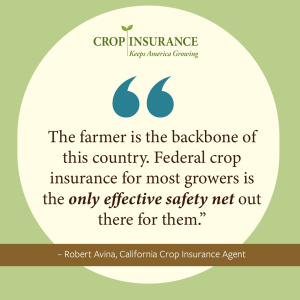Farmers don’t profit from crop insurance. They’d rather grow a crop than file a claim.
Crop insurance keeps America’s farmers growing after disaster. It’s the cornerstone of the farm safety net, and an integral risk management tool for family farmers.
But activist critics are not afraid to use misleading claims to dismantle the farm safety net, hurting the family farmers who depend on crop insurance. Criticisms that farmers somehow profit when they file crop insurance claims or would rather file a claim than grow a crop are not only false, but also run counter to the hardworking ethics of the American farmer.
Let’s explore how crop insurance works.
Farmers purchase crop insurance before they plant.
Farmers work with private-sector crop insurance agents to purchase a crop insurance policy before they plant a crop. The policy is personalized to the unique risks and needs of that farm.
Farmers pay to purchase crop insurance policies…
Farmers are required to invest in their own protection and share in the risk. Last year, America’s farmers collectively paid $6.8 billion to purchase crop insurance premiums. As Senator Debbie Stabenow (D-MI), Chairwoman of the Senate Agriculture Committee said, “Our farmers, they’re not asking for a handout.”
…that are made affordable through government discounts.
The Federal government provides discounts to ensure it remains affordable for farmers. Many farmers – especially young and beginning farmers – are already operating on tight profit margins. Increasing the cost of crop insurance would be devastating.
So, after a farmer purchases crop insurance, what next? They grow their crops, raise their livestock, follow Good Farming Practices, claim. It’s an investment into the protection of their family farm.
“Most every farmer truly buys [crop insurance] and hopes they never use it. We would much prefer to make a good crop and sell it at a good price… but those years come that you’re going to need it. And being able to have something to lean on, to know that you’re going to be in business next year is a big deal,” said South Carolina farmer Landrum Weathers.
But if a disaster strikes the farm, farmers need help – fast.
Famers can’t afford to wait years for Congress to approve emergency disaster aid. Farmers need aid now to settle forward marketing contracts for crops that were destroyed, purchase livestock feed after their fields were sapped by drought, or pay back the the operating loan that went towards seed, fertilizer, and other expenses for a crop that never made it to harvest.
Farmers file a claim with their crop insurance agent.
Private-sector crop insurance claims adjusters quickly and accurately assess damages and calculate losses. Delivering aid based on actual losses protects farmers and taxpayers.
Farmers quickly receive aid…
Farmers receive help in just days or weeks, making crop insurance faster than disaster aid.
…minus an average 25% deductible.
Farmers must shoulder a deductible, which is on average about 25% of the value of the loss they experienced. In that way, crop insurance is like other types of insurance. If you have a car accident, you must pay a certain amount before your insurance kicks in.
At the end of the day, crop insurance must be actuarially sound with a loss ratio performance mandate of “not greater than 1.0.” That means that over time, indemnity payments paid out to farmers should equal the total premiums invested into the system.
So, while the Federal government is an invaluable partner in ensuring that crop insurance remains affordable, farmers are still paying into the system. They’re relying on crop insurance to help them survive a disaster so they can plant again the next season, not turn a profit.
“Crop insurance kind of provides a safety net to where you know what the minimum return is going to be. And if you can live with that minimum return and then, you know, you can survive and go forward,” Arkansas farmer Tim Ralston told us when we visited his farm last summer.
That is why a robust crop insurance program is essential to all Americans. Crop insurance protects the farmers who grow our food and strengthens our national food security.








 A mule-drawn cultivating team in the 1910’s. Around the time this photo was taken, the crop insurance industry started the agronomic research program that is still working today to understand the impact of nature’s perils on crops.
A mule-drawn cultivating team in the 1910’s. Around the time this photo was taken, the crop insurance industry started the agronomic research program that is still working today to understand the impact of nature’s perils on crops. Simulating hail with an ice blowing machine. The crop insurance industry funded the development of these machines in the 1980’s to simulate realistic crop damage for loss adjuster schools. They are still in use today.
Simulating hail with an ice blowing machine. The crop insurance industry funded the development of these machines in the 1980’s to simulate realistic crop damage for loss adjuster schools. They are still in use today. NCIS conducts research across the country. North Dakota is a favorite research location because it is the northernmost location for a diversity of insured crops. In the late 1970’s and early 1980’s, sunflower research was prolific in North Dakota!
NCIS conducts research across the country. North Dakota is a favorite research location because it is the northernmost location for a diversity of insured crops. In the late 1970’s and early 1980’s, sunflower research was prolific in North Dakota!
 “Wheat farmers rely on the certainty of the crop insurance program. In turn, the American people can depend on American farmers who are able to…withstand natural disasters.” – Brent Cheyne, President, National Association of Wheat Growers
“Wheat farmers rely on the certainty of the crop insurance program. In turn, the American people can depend on American farmers who are able to…withstand natural disasters.” – Brent Cheyne, President, National Association of Wheat Growers





